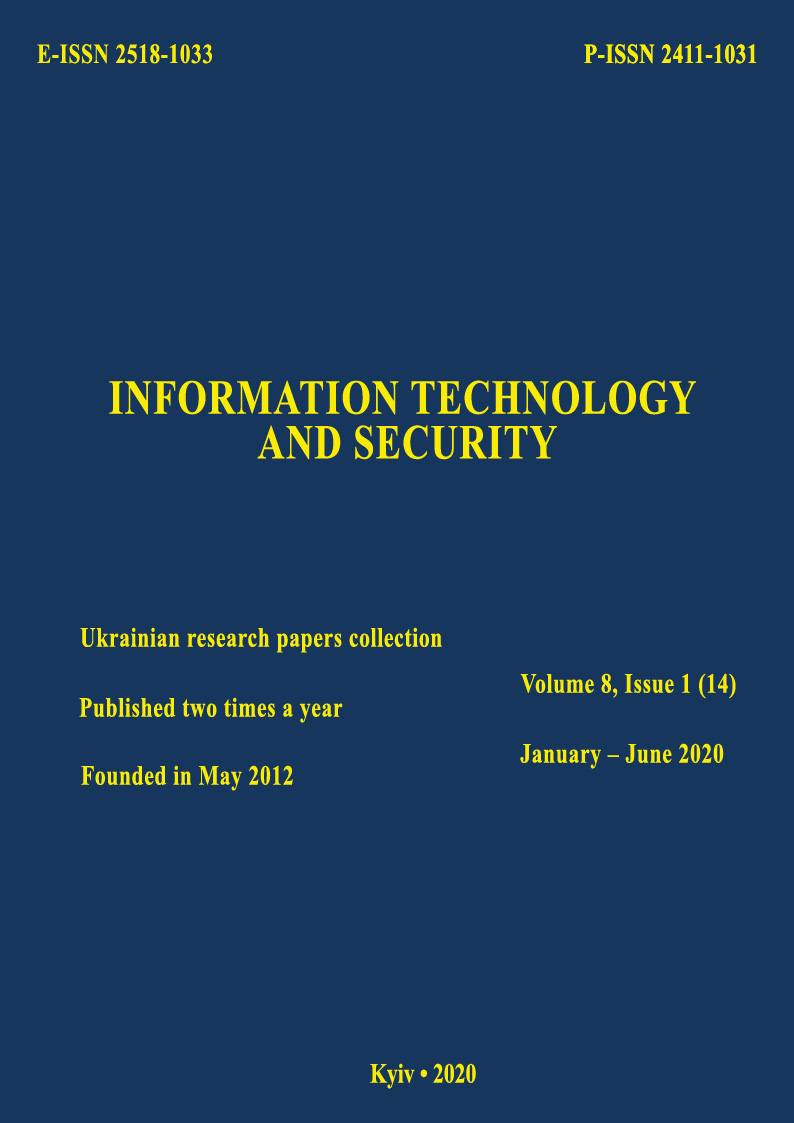Analysis of information-psychological impact detection methods in social networks
DOI:
https://doi.org/10.20535/2411-1031.2020.8.1.218002Keywords:
information-psychological impact, machine learning, neural networks, lexeme-oriented approach, sentiment analysisAbstract
Methods with the help of which it is possible to carry out automatic content analysis in social networks for the detection information-psychological impact are analyzed. Based on the performed research, the features of the virtual communities functioning in social networks were determined. Virtual communities have become objects and tools of external information management and the information confrontation arena at different levels. They have become an ideal tool for information-psychological impact on the national interests of the state, society in the information, and cyberspace, in general. To prevent and counteract shocks in society, it is necessary to constantly monitor the presence of negative informational-psychological impact in communities to be able to resist it. Methods for detecting information-psychological impact include methods based on the use of lexemes and machine learning with a teacher, namely: support vector machine, the naive Bayes classifier, decision trees, the method of maximum entropy, and neural networks. Each of the analyzed methods has its own advantages and disadvantages, features of use, which must be taken into account when choosing a method for detecting information-psychological impact in social networks. Among the methods considered for automatic content analysis, the most effective method is a machine learning based on the use of neural networks. This method does not involve pre-processing of text, there is no need to create dictionaries, can classify into several categories. This allows identifying different types of information-psychological impact by training the network with new information. So, updates of content in social networks are taken into account. It has been established that unlike neural networks, the decision tree for detecting information-psychological impact cannot be used in practice. This limitation is due to the difficulty of maintaining incremental training. You can take a large amount of data and build a decision tree for it. However, it is impossible to take into account new messages, because you will have to teach it from scratch every time.
References
K. Molodetska-Grinchuk, “ Method for identifying signs of information impacts in social Internet services based on their content ”, Radio electronics, informatics, management, no. 2, pp. 117-126, 2017, doi: https://doi.org/10.15588/1607-3274-2017-2-13.
R. Grischuk, and K. Molodetska-Grinchuk, “ Methodology of building a system to ensure information security of the state in social Internet services ”, Information Protection, vol. 19, no. 4, pp. 25-262, 2017, doi: https://doi.org/10.18372/2410-7840.19.12204.
Most famous social network sites worldwide as of October 2018, ranked by number of active users (in millions). [Online]. Available: https://www.statista.com/statistics/272014/global-social-networks-ranked-by-number-of-users/. Accessed on: October 17, 2019.
А. Solovey. “Virtual communities as a special form of social integration”, Psychology, sociology and education, no. 6(33), pp. 33-41, 2014. [Online]. Available: http://psychology.snauka.ru/2014/06/3341. Accessed on: February 10, 2020.
V. Gorbulin, A. Dodonov, and D. Lande, Information operations and public safety: threats, counteraction, modeling, Kyiv, Ukraine: Intertechnology, 2009.
K. Sangwook, Y. Zhibin, M. Rhee, and L. Minho, “Deep learning of support vector machines with class probability output networks”, Neural Networks, vol. 64, no. C, pp.19-28, 2015, doi: https://doi.org/10.1016/j.neunet.2014.09.007.
D. Guthrie, “Unsupervised detection of anomalous text”, Doctor of Philosophy, Department of Computer Science, University of Sheffield, Sheffield, England, 2008.
S. Baccianella, A. Esuli, and F.Sebastiani, “Sentiwordnet 3.0: An enhanced lexical resource for sentiment analysis and opinion mining”, in Proceedings of LREC, 2010, pp. 2200-2204.
P. Stone, “A computer approach to content analysis: Studies using the general inquirer system”, in Spring Joint Computer Conference, New York, 1963, pp. 241-256.
Text classification using neural networks and TensorFlow. [Online]. Available: https://tproger.ru/translations/text-classificationtensorflow-neural-networks. Accessed on: July 17, 2019.
A.Karpathy, “The Unreasonable Effectiveness of Recurrent Neural Networks”, Andrej Karpathy blog, 2015. [Online]. Available: http://karpathy.github.io/2015/05/21/rnn-effectiveness/. Accessed on: April 12, 2019.
I. Witten, E. Frank, and M. Hall, Data Mining: Practical Machine Learning Tools and Techniques 3rd Edition. Waltham, USA: Morgan Kaufmann, 2011.
K. Nigam, “Using maximum entropy for text classification”, in IJCAI99 workshop on machine learning for information filtering, 1999, pp. 61-67.
R. Byrd, S. Hansen, J. Nocedal, and Y. Singer “A Stochastic Quasi-Newton Method for Large-Scale Optimization”, SIAM Journal on Optimization, vol. 26, no. 2, pp. 1008-1031, 2016, doi: https://doi.org/10.1137/140954362.
Downloads
Published
How to Cite
Issue
Section
License
Copyright (c) 2020 Information technology and security

This work is licensed under a Creative Commons Attribution 4.0 International License.
The authors that are published in this collection, agree to the following terms:
- The authors reserve the right to authorship of their work and pass the collection right of first publication this work is licensed under the Creative Commons Attribution License, which allows others to freely distribute the published work with the obligatory reference to the authors of the original work and the first publication of the work in this collection.
- The authors have the right to conclude an agreement on exclusive distribution of the work in the form in which it was published this anthology (for example, to place the work in a digital repository institution or to publish in the structure of the monograph), provided that references to the first publication of the work in this collection.
- Policy of the journal allows and encourages the placement of authors on the Internet (for example, in storage facilities or on personal web sites) the manuscript of the work, prior to the submission of the manuscript to the editor, and during its editorial processing, as it contributes to productive scientific discussion and positive effect on the efficiency and dynamics of citations of published work (see The Effect of Open Access).

